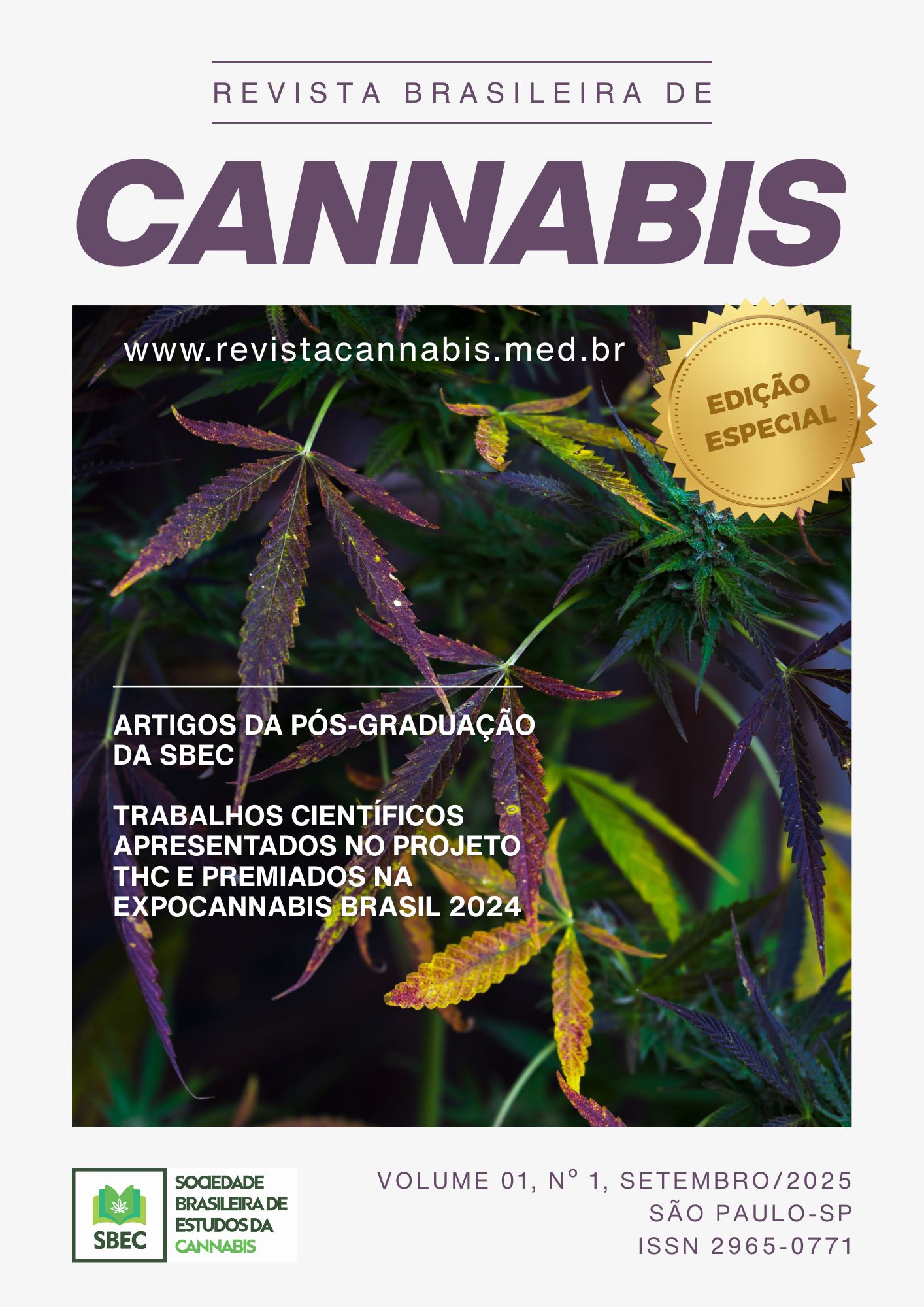CANNABIS NA GERIATRIA E GERONTOLOGIA: ALZHEIMER
DOI:
https://doi.org/10.58731/2965-0771.2025.121Abstract
Population aging is a global trend, with projections indicating that the number of people aged 65 and over is expected to double in the next three decades. With aging, the risk of chronic conditions such as dementia increases, which could account for 139 million cases by 2050. Alzheimer's disease ("AD"), recognized as a global public health problem, is the most prevalent cause of dementia and may account for 60-70% of cases. AD is characterized by memory deficits and deterioration of multiple cognitive functions, involving beta-amyloid protein deposits, tau protein neurofibrillary tangles, inflammation, and neuronal loss. Conventional treatments do not halt or reverse the neurodegenerative process. In this context, activation of the endocannabinoid system ("ECS"), which regulates physiological processes such as mood, appetite, and sleep, and whose activity is neuroprotective, emerges as a potential therapeutic approach for AD symptoms. Experimental and postmortem studies in human brains with AD have identified alterations in the ECS, with elevated levels of endocannabinoids (anandamide and 2-arachidonylglycerol) and their metabolizing enzymes in degenerated brain regions. Activation of CB1 and CB2 receptors (the main ECS receptors) by natural or synthetic agonists has demonstrated beneficial effects in experimental models of Alzheimer's disease, including reduced neuroinflammation, excitotoxicity, mitochondrial dysfunction, and oxidative stress. Although still in its infancy, the use of cannabinoids in the treatment of Alzheimer's disease is a growing reality in Brazil and worldwide. Scientific data point to the ability of cannabinoids to reduce neuroinflammation, neurotoxicity, excitotoxicity, apoptosis, and oxidative stress, in addition to stimulating neurogenesis and cerebral blood flow. Symptoms such as insomnia, paranoia, anxiety, dysphoria, pain, appetite loss, and weight loss may respond to cannabis therapy. However, there is a need to expand access to the plant and the technical-scientific debate to improve knowledge about the cellular mechanisms of cannabinoids, as well as to conduct more long-term randomized controlled studies exploring different types of cannabis-based medicines, the neuroprotective potential of cannabinoid compounds, their underlying mechanisms, and their combinations.
Keywords: Alzheimer's; Cannabinoids; Endocannabinoid System; Neuroprotection.
References
[1] United Nations, Department of Economic and Social Affairs. 2023. World Social Report 2023: Leaving No One Behind In An Ageing World. Disponível em: <https://www.un.org/development/desa/dspd/wp-content/uploads/sites/22/2023/01/2023wsr-fullreport.pdf>. Acesso em: 14/02/2023.
[2] Jean-Marie Robine (2021). Ageing populations: We are living longer lives, but are we healthier? United Nations, Department of Economics and Social Affairs, Population Division, UN DESA/POP/2021/TP/NO. 2. Disponível em: <https://desapublications.un.org/file/653/download>. Acesso em: 14/02/2023.
[3] Mahmood SS, Levy D, Vasan RS, Wang TJ. The Framingham Heart Study and the epidemiology of cardiovascular disease: a historical perspective. Lancet. 2014 Mar 15;383(9921):999-1008. doi: 10.1016/S0140-6736(13)61752-3. Epub 2013 Sep 29. PMID: 24084292; PMCID: PMC4159698. Disponível em: <https://www.ncbi.nlm.nih.gov/pmc/articles/PMC4159698/>. Acesso em: 13/02/2023.
[4] Kalra, S., Sharma, S.K. Diabetes in the Elderly. Diabetes Ther 9, 493–500 (2018). https://doi.org/10.1007/s13300-018-0380-x. Disponível em: < https://link.springer.com/article/10.1007/s13300-018-0380-x#citeas>. Acesso em: 27/02/2023.
[5] van der Flier WM, Scheltens P. Epidemiology and risk factors of dementia. Journal of Neurology, Neurosurgery & Psychiatry 2005;76:v2-v7. Disponível em: <https://jnnp.bmj.com/content/76/suppl_5/v2>. Acesso em: 13/02/2023.
[6] Andrews-Hanna JR, Snyder AZ, Vincent JL, Lustig C, Head D, Raichle ME, Buckner RL. Disruption of large-scale brain systems in advanced aging. Neuron. 2007 Dec 6;56(5):924-35. doi: 10.1016/j.neuron.2007.10.038. PMID: 18054866; PMCID: PMC2709284. Disponível em: <https://www.cell.com/neuron/fulltext/S0896-6273(07)00864-1?_returnURL=https%3A%2F%2Flinkinghub.elsevier.com%2Fretrieve%2Fpii%2FS0896627307008641%3Fshowall%3Dtrue>. Acesso em: 05/05/2023.
[7] Jager, G., & Witkamp, R. (2014). The endocannabinoid system and appetite: Relevance for food reward. Nutrition Research Reviews, 27(1), 172-185. doi:10.1017/S0954422414000080. Disponível em: < https://www.cambridge.org/core/journals/nutrition-research-reviews/article/endocannabinoid-system-and-appetite-relevance-for-food-reward/30C65E719848770761B6BEA7D0C1E9CB>. Acesso em: 28/02/2023.
[8] Hasbi A, Madras BK, George SR. Endocannabinoid System and Exogenous Cannabinoids in Depression and Anxiety: A Review. Brain Sciences. 2023; 13(2):325. https://doi.org/10.3390/brainsci13020325. Disponível em: <https://www.mdpi.com/2076-3425/13/2/325>. Acesso em: 14/02/2023.
[9] Bilkei-Gorzo A. (2012). The endocannabinoid system in normal and pathological brain ageing. Philosophical transactions of the Royal Society of London. Series B, Biological sciences, 367(1607), 3326–3341. Disponível em: <https://www.ncbi.nlm.nih.gov/pmc/articles/PMC3481530/>. Acesso em: 13/02/2023.
[10] Maroon J, Bost J. Review of the neurological benefits of phytocannabinoids. Surg Neurol Int. 2018 Apr 26;9:91. doi: 10.4103/sni.sni_45_18. PMID: 29770251; PMCID: PMC5938896. Disponível em: < https://www.ncbi.nlm.nih.gov/pmc/articles/PMC5938896/>. Acesso em: 27/02/2023.
[11] Gammon, K. Neurodegenerative disease: Brain windfall. Nature 515, 299–300 (2014). https://doi.org/10.1038/nj7526-299a. Disponível em: <https://www.nature.com/articles/nj7526-299a>. Acesso em: 13/02/2023.
[12] Freitas, E. (2013). A detecção da aterosclerose subclínica pode modificar o risco de desenvolvimento da doença cerebrovascular? Disponível em: <https://www.e-publicacoes.uerj.br/index.php/revistahupe/article/download/7081/5073>. Acesso em: 19/03/2023
[13] Ferri CP, Prince M, Brayne C, Brodaty H, Fratiglioni L, Ganguli M, Hall K, Hasegawa K, Hendrie H, Huang Y, Jorm A, Mathers C, Menezes PR, Rimmer E, Scazufca M; Alzheimer's Disease International. Global prevalence of dementia: a Delphi consensus study. Lancet. 2005 Dec 17;366(9503):2112-7. doi: 10.1016/S0140-6736(05)67889-0. PMID: 16360788; PMCID: PMC2850264. Disponível em: <https://pubmed.ncbi.nlm.nih.gov/16360788/>. Acesso em: 20/04/2023.
[14] World Health Organization. (2022). Dementia. Disponível em: <https://www.who.int/news-room/fact-sheets/detail/dementia>. Acesso em: 10/02/2023.
[15] Gauthier S, Webster C, Servaes S, Morais JA, Rosa-Neto P. 2022. World Alzheimer Report 2022: Life after diagnosis: Navigating treatment, care and support. London, England: Alzheimer’s Disease International. Disponível em: <https://www.alzint.org/u/World-Alzheimer-Report-2022.pdf>. Acesso em: 10/02/2023.
[16] Sociedade Brasileira de Geriatria e Gerontologia. (2019). Em Dia Mundial do Alzheimer, dados ainda são subestimados, apesar de avanços no diagnóstico e tratamento da doença. Disponível em: <https://sbgg.org.br/em-dia-mundial-do-alzheimer-dados-ainda-sao-subestimados-apesar-de-avancos-no-diagnostico-e-tratamento-da-doenca/>. Acesso em: 19/03/2023.
[17] Alzheimer’s Disease International (2010). World Alzheimer Report 2010: The global economic impact of dementia. London: ADI. Disponível em: < https://www.alzint.org/u/WorldAlzheimerReport2010.pdf>. Acesso em: 08/02/2023.
[18] MACHADO, J. C. (Ed.). Tratado de geriatria e gerontologia. 3. ed. Rio de Janeiro: Guanabara Koogan, 2011.
[19] Yuan, P., Zhang, M., Tong, L. et al. PLD3 affects axonal spheroids and network defects in Alzheimer’s disease. Nature 612, 328–337 (2022). https://doi.org/10.1038/s41586-022-05491-6. Disponível em: < https://www.nature.com/articles/s41586-022-05491-6#citeas>. Acesso em: 02/02/2023.
[20] De Strooper B, Karran E. The Cellular Phase of Alzheimer's Disease. Cell. 2016 Feb 11;164(4):603-15. doi: 10.1016/j.cell.2015.12.056. PMID: 26871627. Disponível em: <https://pubmed.ncbi.nlm.nih.gov/26871627/>. Acesso em: 02/02/2023.
[21] Chierrito, TPC. Síntese de potencial inibidor de acetilcolinesterase para tratamento da Doença de Alzheimer. 2016. 191f. Tese (Doutorado). Faculdade de Ciências Farmacêuticas de Ribeirão Preto – Universidade de São Paulo, Ribeirão Preto. Disponível em: <https://teses.usp.br/teses/disponiveis/60/60138/tde-02052016-092044/publico/Tese_Corrigida_Completa.pdf >. Acesso em: 02/02/2023.
[22] Stone NL, Murphy AJ, England TJ, O'Sullivan SE. A systematic review of minor phytocannabinoids with promising neuroprotective potential. Br J Pharmacol. 2020 Oct;177(19):4330-4352. doi: 10.1111/bph.15185. Epub 2020 Sep 1. PMID: 32608035; PMCID: PMC7484504. Disponível em: <https://pubmed.ncbi.nlm.nih.gov/32608035/>. Acesso em: 02/02/2023.
[23] Ministério da Saúde (Brasil). Portaria nº 13, de 2017. Protocolo Clínico e Diretrizes Terapêuticas da Doenças de Alzheimer. Disponível em: <https://www.gov.br/saude/pt-br/assuntos/protocolos-clinicos-e-diretrizes-terapeuticas-pcdt/arquivos/2020/portaria-conjunta-13-pcdt-alzheimer-atualizada-em-20-05-2020.pdf>. Acesso em: 03/03/2023.
[24] Howard R, McShane R, Lindesay J, et al. Donepezil and memantine for moderate-to-severe Alzheimer's disease. N Engl J Med. 2012 366:893-903. Disponível em: <https://www.nejm.org/doi/full/10.1056/NEJMoa1106668>. Acesso em: 02/03/2023.
[25] Morales P, Reggio PH. Emerging Roles of Cannabinoids and Synthetic Cannabinoids in Clinical Experimental Models. Adv Exp Med Biol. 2021;1264:47-65. doi: 10.1007/978-3-030-57369-0_4. PMID: 33332003. Disponível em: <https://pubmed.ncbi.nlm.nih.gov/33332003/>. Acesso em: 02/02/2022.
[26] Maroof N, Pardon MC, Kendall DA. Endocannabinoid signalling in Alzheimer's disease. Biochem Soc Trans. 2013 Dec;41(6):1583-7. doi: 10.1042/BST20130140. PMID: 24256258. Disponível em: < https://pubmed.ncbi.nlm.nih.gov/24256258/>. Acesso em: 02/02/2022.
[27] Nocetti, C. T., Ribeiro, T. G. L. Uso de canabinoides como adjuvante no tratamento da Doença de Alzhemer. Brazilian Journal of Surgery and Clinical Research. v 32, n. 3, p.104-111, nov. 2020. Disponível em:
<https://www.mastereditora.com.br/periodico/20201106_103301.pdf>. Acesso em: 02/02/2022.
[28] López, A., Aparicio, N., Pazos, M.R. et al. Cannabinoid CB2 receptors in the mouse brain: relevance for Alzheimer’s disease. J Neuroinflammation 15, 158 (2018). Disponível em: <https://doi.org/10.1186/s12974-018-1174-9>. Acesso em: 02/02/2022.
[29] Aso E, Ferrer I. Cannabinoids for treatment of Alzheimer's disease: moving toward the clinic. Front Pharmacol. 2014 Mar 5;5:37. doi: 10.3389/fphar.2014.00037. PMID: 24634659; PMCID: PMC3942876. Disponível em: <https://pubmed.ncbi.nlm.nih.gov/24634659/>. Acesso em: 02/03/2023.
[30] Karl T, Cheng D, Garner B, Arnold JC. The therapeutic potential of the endocannabinoid system for Alzheimer's disease. Expert Opin Ther Targets. 2012 Apr;16(4):407-20. doi: 10.1517/14728222.2012.671812. Epub 2012 Mar 27. PMID: 22448595. Disponível em: <https://pubmed.ncbi.nlm.nih.gov/22448595/>. Acesso em: 10/02/2023.
[31] World Health Organization. (2023). English/French list of 218 non-State actors in official relations with WHO reflecting decisions of the 152nd session of the Executive Board. Disponível em: <https://cdn.who.int/media/docs/default-source/executive-board/list-of-entities-in-official-relations-with-who.pdf?sfvrsn=c04e75ba_3&download=true>. Acesso em: 10/02/2023.
[32] Ditchfield, J., & Thomas, M. (2014). The Medical Cannabis Guidebook: The definitive guide to using and growing medicinal marijuana. Green Candy Press.
[33] Eubanks LM, Rogers CJ, Beuscher AE 4th, Koob GF, Olson AJ, Dickerson TJ, Janda KD. A molecular link between the active component of marijuana and Alzheimer's disease pathology. Mol Pharm. 2006 Nov-Dec;3(6):773-7. doi: 10.1021/mp060066m. PMID: 17140265; PMCID: PMC2562334. Disponível em: < https://www.ncbi.nlm.nih.gov/pmc/articles/PMC2562334/#R2>. Acesso em: 02/03/2023.
[34] Shelef A, Barak Y, Berger U, Paleacu D, Tadger S, Plopsky I, Baruch Y. Safety and Efficacy of Medical Cannabis Oil for Behavioral and Psychological Symptoms of Dementia: An-Open Label, Add-On, Pilot Study. J Alzheimers Dis. 2016;51(1):15-9. doi: 10.3233/JAD-150915. PMID: 26757043. Disponível em: < https://pubmed.ncbi.nlm.nih.gov/26757043/>. Acesso em: 02/03/2023.
[35] Bloomfield MAP, Green SF, Hindocha C, et al. The effects of acute cannabidiol on cerebral blood flow and its relationship to memory: An arterial spin labelling magnetic resonance imaging study. Journal of Psychopharmacology. 2020;34(9):981-989. doi:10.1177/0269881120936419. Disponível em: < https://journals.sagepub.com/doi/10.1177/0269881120936419>. Acesso em: 03/02/2023.
[36] Iuvone, T., Esposito, G., De Filippis, D., Scuderi, C., & Steardo, L. (2009). Cannabidiol: A promising drug for neurodegenerative disorders? CNS Neuroscience and Therapeutics, 15(1), 65–75. https://doi.org/10.1111/j.1755-5949.2008.00065.x. Disponível em: < https://pubmed.ncbi.nlm.nih.gov/19228180/>. Acesso em: 02/02/2023.
[37] Mechoulam R, Parker LA. The endocannabinoid system and the brain. Annu Rev Psychol. 2013;64:21-47. doi: 10.1146/annurev-psych-113011-143739. Epub 2012 Jul 12. PMID: 22804774. Disponível em: <https://pubmed.ncbi.nlm.nih.gov/22804774/>. Acesso em: 13/02/2023.
[38] Schubert D, Kepchia D, Liang Z, Dargusch R, Goldberg J, Maher P. Efficacy of Cannabinoids in a Pre-Clinical Drug-Screening Platform for Alzheimer's Disease. Mol Neurobiol. 2019 Nov;56(11):7719-7730. doi: 10.1007/s12035-019-1637-8. Epub 2019 May 19. PMID: 31104297; PMCID: PMC6815693. Disponível em: <https://pubmed.ncbi.nlm.nih.gov/31104297/>. Acesso em: 13/02/2023.
[39] Ruthirakuhan M, Herrmann N, Andreazza AC, Verhoeff NPLG, Gallagher D, Black SE, Kiss A, Lanctôt KL. Agitation, Oxidative Stress, and Cytokines in Alzheimer Disease: Biomarker Analyses From a Clinical Trial With Nabilone for Agitation. J Geriatr Psychiatry Neurol. 2020 Jul;33(4):175-184. doi: 10.1177/0891988719874118. Epub 2019 Sep 23. PMID: 31547752. Disponível em: <https://pubmed.ncbi.nlm.nih.gov/31547752/>. Acesso em: 03/02/2023.
[40] Woodward MR, Harper DG, Stolyar A, Forester BP, Ellison JM. Dronabinol for the treatment of agitation and aggressive behavior in acutely hospitalized severely demented patients with noncognitive behavioral symptoms. Am J Geriatr Psychiatry. 2014 Apr;22(4):415-9. doi: 10.1016/j.jagp.2012.11.022. Epub 2013 Apr 15. PMID: 23597932. Disponível em: <https://pubmed.ncbi.nlm.nih.gov/23597932//>. Acesso em: 03/02/2023.
[41] Oikonomou, P., Jost, W.H. Randomized controlled trials on the use of cannabis-based medicines in movement disorders: a systematic review. J Neural Transm 129, 1247–1256 (2022). https://doi.org/10.1007/s00702-022-02529-x. Disponível em: <https://link.springer.com/article/10.1007/s00702-022-02529-x>. Acesso em: 20/05/2023.
[42] Pratt, M., Stevens, A., Thuku, M. et al. Benefits and harms of medical cannabis: a scoping review of systematic reviews. Syst Rev 8, 320 (2019). https://doi.org/10.1186/s13643-019-1243-x. Disponível em: < https://systematicreviewsjournal.biomedcentral.com/articles/10.1186/s13643-019-1243-x#rightslink>. Acesso em: 23/02/2023.
Downloads
Published
How to Cite
Issue
Section
License
Copyright (c) 2025 Revista Brasileira de Cannabis

This work is licensed under a Creative Commons Attribution 4.0 International License.





